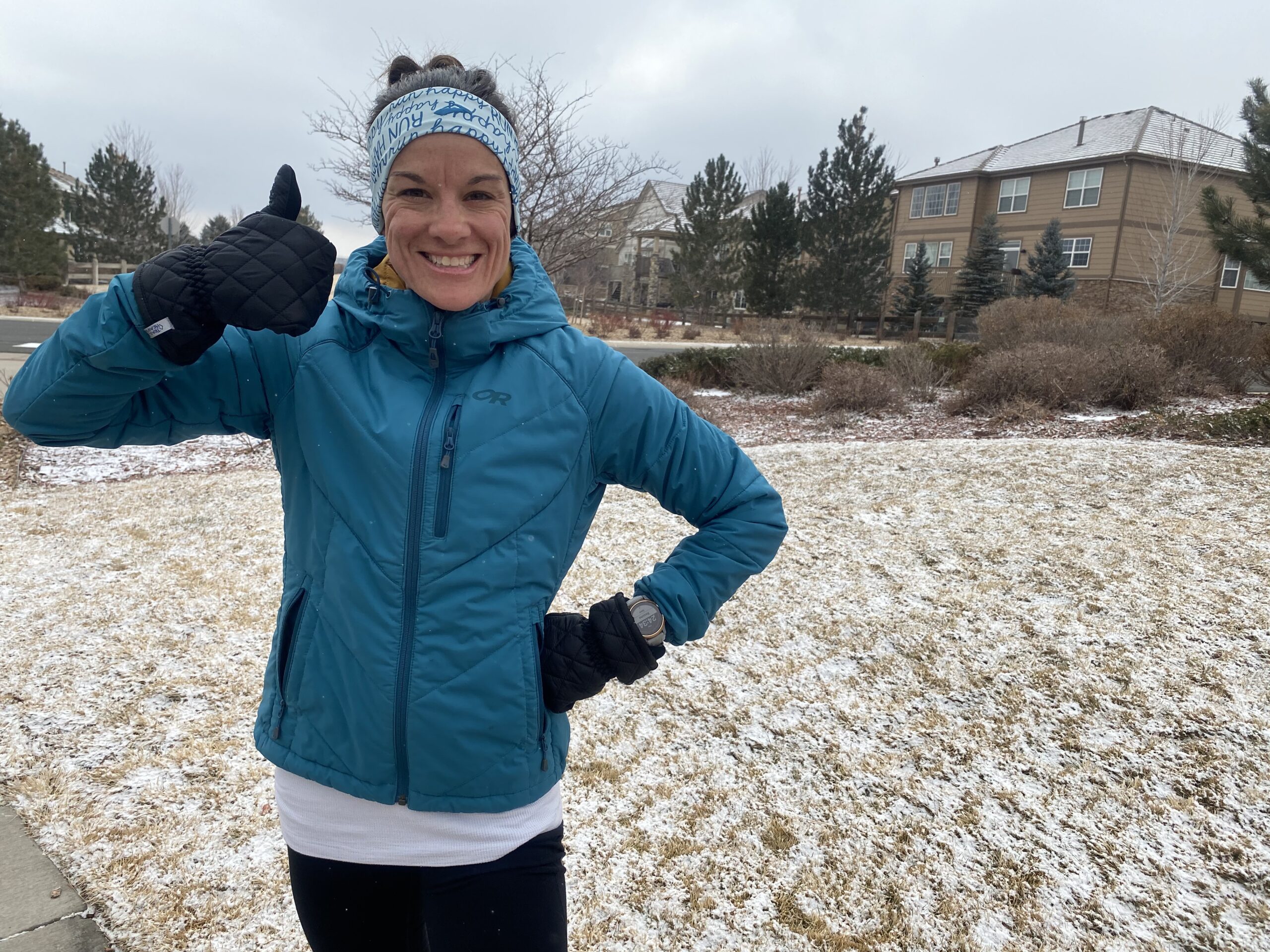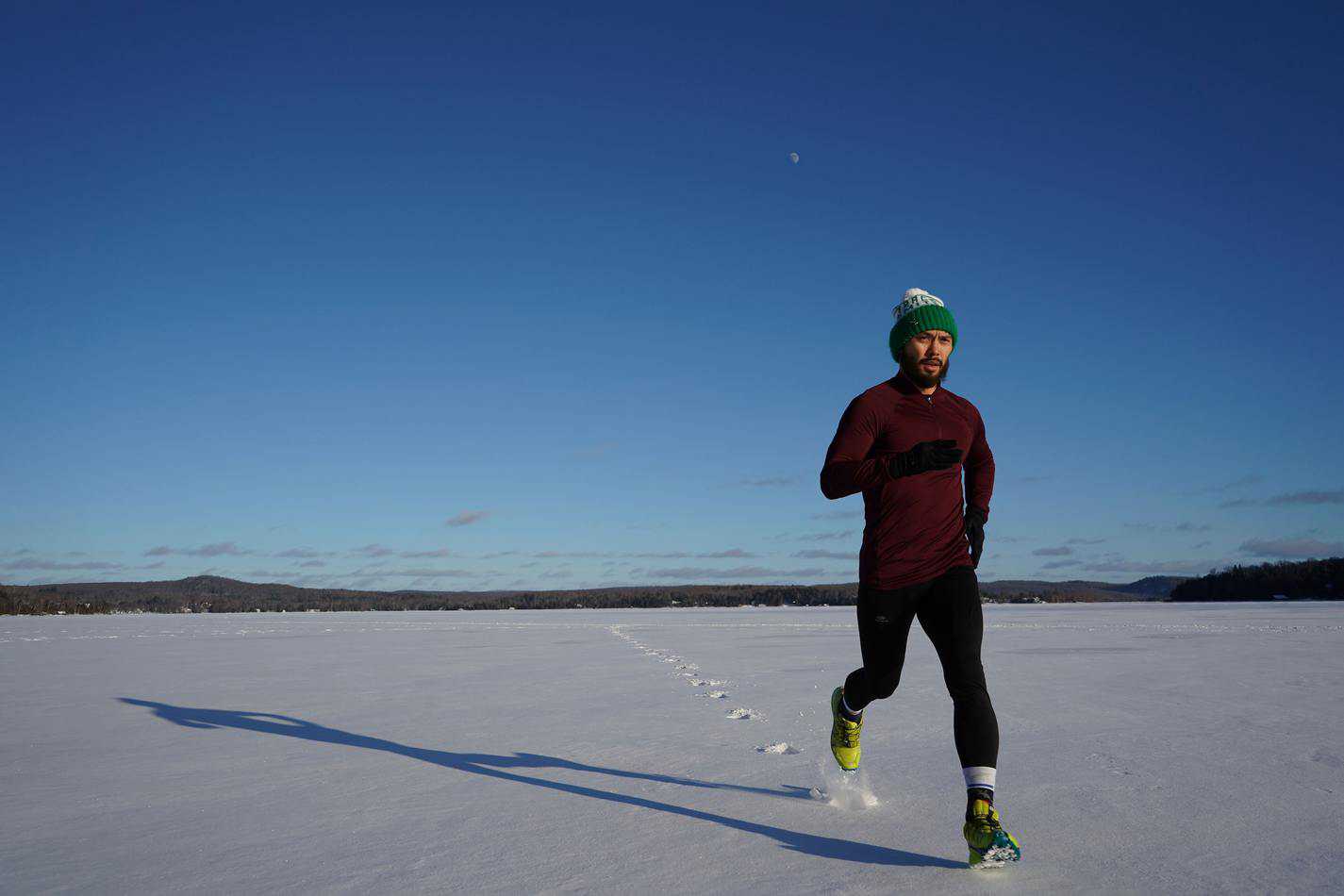For those of us living in colder climates, winter means cold-weather running. It’s a time to dig out our beanies, mittens, running pants, long sleeve shirts and running jacket to stay warm. However, many runners take seasonal temperature drops as a sign to take their running indoors for the next several months or take time off from running thinking it may not be wise (or enjoyable).
The truth is that it’s typically fine to run outdoors in cold weather as long as you have the proper gear to keep your body warm and are keeping a close eye on temperatures and conditions, in order to keep yourself as safe as possible. In rare cases it may be too cold to run outside.
Cold weather should not mean the end of your outdoor running. We’ll share reasons why you should learn to run in most cold weather as well as the risks associated with certain cold weather running so you can make an informed decision about what’s best.
Deciding if You Should Run in Cold Weather
Unless there are extreme cold weather events happening outside – such as a blizzard, an ice storm, or severe windchills – you can and should keep running in cold weather as long as you have the proper gear. The main reason people have difficulty running in the cold is usually related to wearing improper clothing that doesn’t keep their core temperature warm enough. Layering up with clothing made of moisture wicking material will keep you comfortable and dry even in inclement weather.
RELATED VIDEO: What to Wear for Cold Weather Running
As my best running friend likes to say, there is no such thing as bad weather, just bad gear. We have grown to relish runs when the outside temperature drops in the fall! There’s something magical about the way the outdoors feels when the air has a crispness and stillness to it that wasn’t there during the days of scorching summer heat.
Being optimally prepared by dressing appropriately will allow you to have an enjoyable winter run. And though you may be chilly as you start out, no doubt you will warm up as the heart rate increases. In fact you may find yourself shedding layers as your running creates more body heat.
Plus, there are many benefits to maintaining your outdoor running through the fall and winter.
6 Benefits of Cold Weather Running
If you’re struggling to justify why you should keep running outside when it’s cold, perhaps this list of benefits will keep you going:
1.) A Regular Dose of Fresh Air
Fresh air is always a sure-fire way to clear the mind and refresh the spirit. Being out in the winter air provides a positive effect, particularly during the colder seasons when we spend most of our days indoors. Being among nature and exercising outdoors helps us gain a new perspective on our day and rejuvenates our mental and physical energy.
2.) Boost Your Mood
Running outdoors when it’s cold helps combat the “winter blues,” which is a type of depression known as seasonal affective disorder (SAD). SAD primarily affects people living in northern regions where daylight is limited during the winter months, according to the National Institutes of Health. Cleveland Clinic states that going outdoors to get more sunlight is a natural way to help improve symptoms associated with SAD.
Furthermore, for those with mild depression, the release of endorphins that come from running can be just as effective as taking antidepressants, according to Harvard Medical School. Outdoor running should be used as a long-term treatment, not a one-run-only fix. Stick with a regular outdoor running routine, like the one shared here to help improve your mood all season long!
3.) Slower Running Paces = Faster Running Later
Cold weather often means ice and snow on the roads and trails, and you’ll have to slow down your pace in order to avoid slipping and falling. While it can be a bummer to see your split times slow way down this time of year, it’s actually a good thing! As we discussed in our article on 80/20 running, and as Coach Jane talked about here on her YouTube channel, your goal as a distance runner is to complete the majority of your runs at a true easy pace.
Slowing down for most of your runs builds your aerobic endurance, which will transform you into a stronger and faster runner over time. Those winter runs where you are forced to slow down are building your aerobic engine properly, so that when the roads clear up in the spring, you’ll be amazed at how much faster you’ve become.
4.) Raise Your Metabolism
Running in cold weather can help boost your energy burn and yes, even raise your metabolism. Several studies have shown that exposure to cool and cold temperatures stimulates an increase in metabolism. This is because the body’s shivering response to lower temperatures causes the body to generate heat in an attempt to maintain proper body temperature. When the body generates more heat, more energy is expended, which means your metabolism is being raised. And who doesn’t love some extra calorie burn?
5.) Build Your Mental Toughness and Confidence
Pretty much any runner can use a boost in mental fortitude. We have all experienced moments of doubt, fear, and negativity on runs, where our minds start complaining and urging us to slow down, or just stop running altogether and go home. If you regularly run outside in cold weather, however, you’ll have plenty of practice silencing the voice in your mind that wants to quit.
I will never forget a particularly cold, snowy run last winter; it was so tempting to turn around and head back to the warm comfort of home! But I forged ahead, slogging through slushy streets for what felt like ages, fighting my negative mindset the whole time. When I finished, I felt so accomplished and proud! Running through cold weather conditions makes us tougher and more confident runners.
And remember, on race day you will have no control over the weather conditions. So forcing yourself to run in colder weather can only serve to prepare you for the days it really counts.
6.) Maintain Consistency
Consistency is a huge factor in your running success over time. By continuing to run during the colder months – even if you’re running less mileage than you might run in warmer months – you are maintaining the consistency that will pay off over time with better running performances. In this video, Coach Jane shares how a lack of consistency is one of the four main ways a runner ends up unknowingly sabotaging their running progress. So maintain some mileage through the off-season so you’re not starting from scratch every time the warm months roll around! Need a winter-specific training plan? Here’s one from renowned running coach Hal Higdon.
Ok so it’s beneficial. But can running in the winter actually be enjoyable?! It really can! We’re confident that if you follow our top 10 tips for running in cold weather you’ll actually learn to really like it.
What Are the Risks of Running in the Cold?
Let’s turn now to the risks associated with running in cold weather. Though rare in most places you’ll probably be running in the world, it’s important to be familiar with and understand the risks. It’s also important to recognize the dangerous warning signs of frostbite and hypothermia, so that you can get help as soon as possible for those symptoms.
Slipping and Falling
Slippery ice can be a risk during winter running. To minimize your risk of falling and hurting yourself in icy conditions, take your runs slowly through questionable patches, and walk or change your route in really difficult sections. To get more traction, check out our list of the best shoes for running on ice and snow, or consider adding screws to the soles which can turn older pair of running shoes into ice spikes. Yaktrax can also be put over your current pair of shoes to provide traction. If the ground surface is questionable to the point that you’ll probably spend most of your run trying not to slip, then play it safe by staying indoors and using a treadmill!
Bronchospasms
Bronchospasms are common occurrences in cold weather, especially for those with asthma, allergies and other lung conditions, according to Cleveland Clinic. The cold air irritates your airways, causing them to tighten and narrow. This limits the amount of oxygen your body can receive and can lead to breathing difficulties. Symptoms can include chest tightness, coughing, wheezing, shortness of breath, tiredness and dizziness.
Heart Attacks
There’s a reason we hear every year about people having heart attacks while shoveling their snowy driveways: cold weather along with physical exertion raises blood pressure, which can lead to heart attacks due to the increased workload placed on the heart, states the American Heart Association. The elderly and those with underlying health conditions such as heart failure, high blood pressure and high cholesterol are at highest risk of experiencing heart attacks when exerting themselves in the cold.
Frostbite
Frostbite is a skin injury caused by very cold temperatures. Any exposed skin is vulnerable. The risk of frostbite is less than 5% when the air temperature is above 5° Fahrenheit (-15°C), but your risk goes up as the temperature drops! For instance, in a windchill of -18°F (-28°C), frostbite can occur on exposed skin in as little as 30 minutes or less! Symptoms of frostbite include numbness, loss of feeling, and stinging or burning on the exposed site. White patches on skin are another early sign, and signify that you need to get indoors quickly.
Frostnip
Frostnip is a milder form of frostbite that is superficial in nature and won’t cause lasting damage or problems. Symptoms include redness, numbness, and tingling on exposed skin areas.
Hypothermia
Hypothermia happens when your body’s internal temperature drops below 95°F due to prolonged exposure to freezing air or freezing water. Your body is losing heat faster than it can be produced, according to Mayo Clinic. Cold and/or wet weather along with exercise increases the risk of hypothermia, with older adults and kids being at highest risk.
Hypothermia is an emergency, and you should seek medical help as soon as possible if you experience the following symptoms: intense shivering, slurred speech, loss of coordination, and fatigue.
The best way to minimize your hypothermia risk when running in the cold is to dress in layers, ensuring that the layer next to your skin is moisture-wicking, synthetic material and keep your feet dry with shoes that are waterproof.
When to Avoid Cold Weather Running
There are times when it’s not advisable or even dangerous to run in cold weather. The primary situations you want to pay attention to – where it’s best to head inside – are the extremes: blizzards, freezing rain, ice storms, and low windchills. Certain temperatures may be unsuitable depending on the gear (or lack thereof) as well.
The Mayo Clinic warns that extremely cold temperatures can make outdoor exercise unsafe, even with the proper warm clothing.Factors that affect temperature include wind, precipitation, and sunlight, all of which vary, so there is no single cutoff temperature for exercising safely outdoors in the cold, according to Real Simple.
Our best advice for cold weather running safety is to always check the weather forecast for windchill and frostbite advisories before heading out. Make sure you dress appropriately for the current conditions, and stay indoors if you have any hesitation. If conditions worsen once you are on your run, you can always cut things short and head indoors! (And P.S. if the treadmill just sounds better than going out in the cold, that is totally ok. This will still allow you to maintain your running fitness.)







